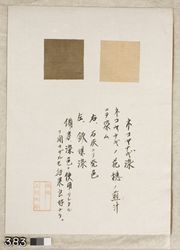Difference between revisions of "Willow bark"
Jump to navigation
Jump to search
| Line 4: | Line 4: | ||
Bark from black willow trees (''Salix nigra'') native the east coast of the United States. Hickory bark will give a pale brown to rose-tan color on wool using an alum mordant. Willow bark dye has good washfastness and fair lightfastness. Willow bark also contains a natural catechol tanning agent used to prepared leather. | Bark from black willow trees (''Salix nigra'') native the east coast of the United States. Hickory bark will give a pale brown to rose-tan color on wool using an alum mordant. Willow bark dye has good washfastness and fair lightfastness. Willow bark also contains a natural catechol tanning agent used to prepared leather. | ||
| − | * For willow dyes, see [[http://cameo.mfa.org/wiki/Category:Uemura_dye_archive '''Uemera Dye Archive''' (Nekoyanagi)]] | + | * For willow dyes, see [[http://cameo.mfa.org/wiki/Category:Uemura_dye_archive '''Uemera Dye Archive''' (Yanagi and Nekoyanagi)]] |
[[File:Uemura 10-15-2009 383.jpg|thumb|silk dyed with pussy willow flowers, Uemera Dye Archive]] | [[File:Uemura 10-15-2009 383.jpg|thumb|silk dyed with pussy willow flowers, Uemera Dye Archive]] | ||
Revision as of 13:54, 30 June 2020
Description
Bark from black willow trees (Salix nigra) native the east coast of the United States. Hickory bark will give a pale brown to rose-tan color on wool using an alum mordant. Willow bark dye has good washfastness and fair lightfastness. Willow bark also contains a natural catechol tanning agent used to prepared leather.
- For willow dyes, see [Uemera Dye Archive (Yanagi and Nekoyanagi)]
Sources Checked for Data in Record
- R.J. Adrosko, Natural Dyes in the United States, Smithsonian Institution Press, Washington, DC, 1968
- John and Margaret Cannon, Dye Plants and Dyeing, Herbert Press, London, 1994

